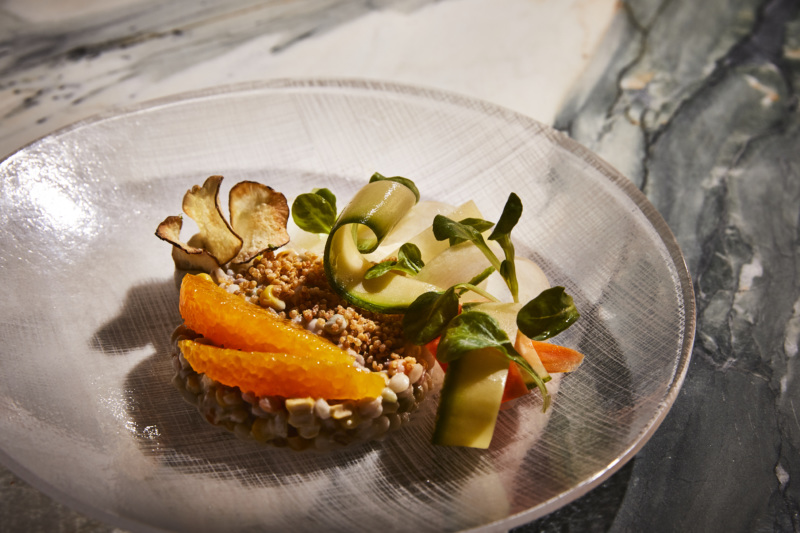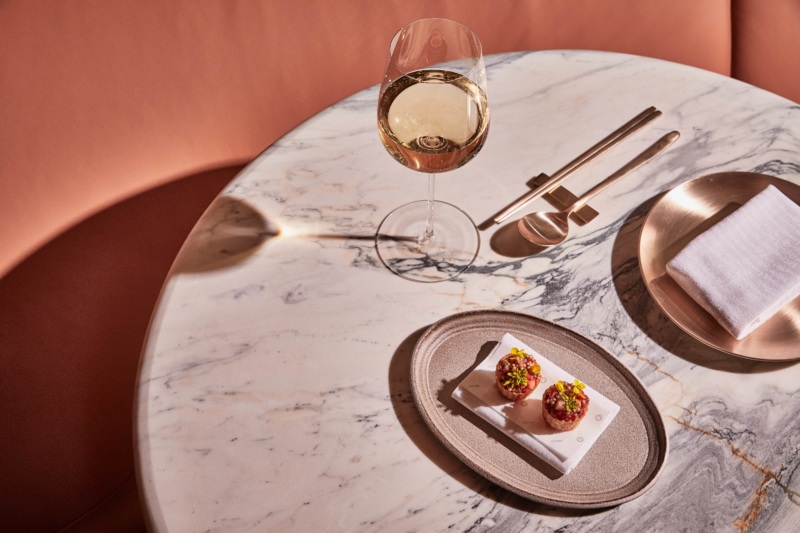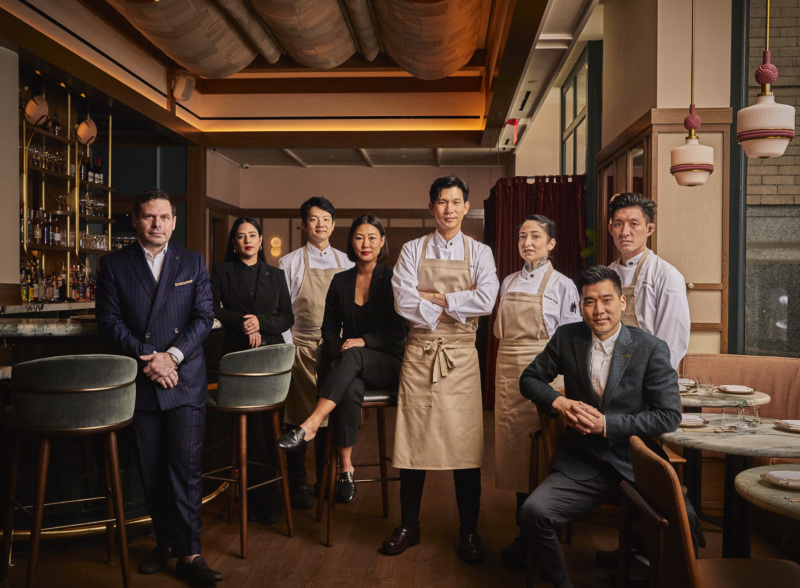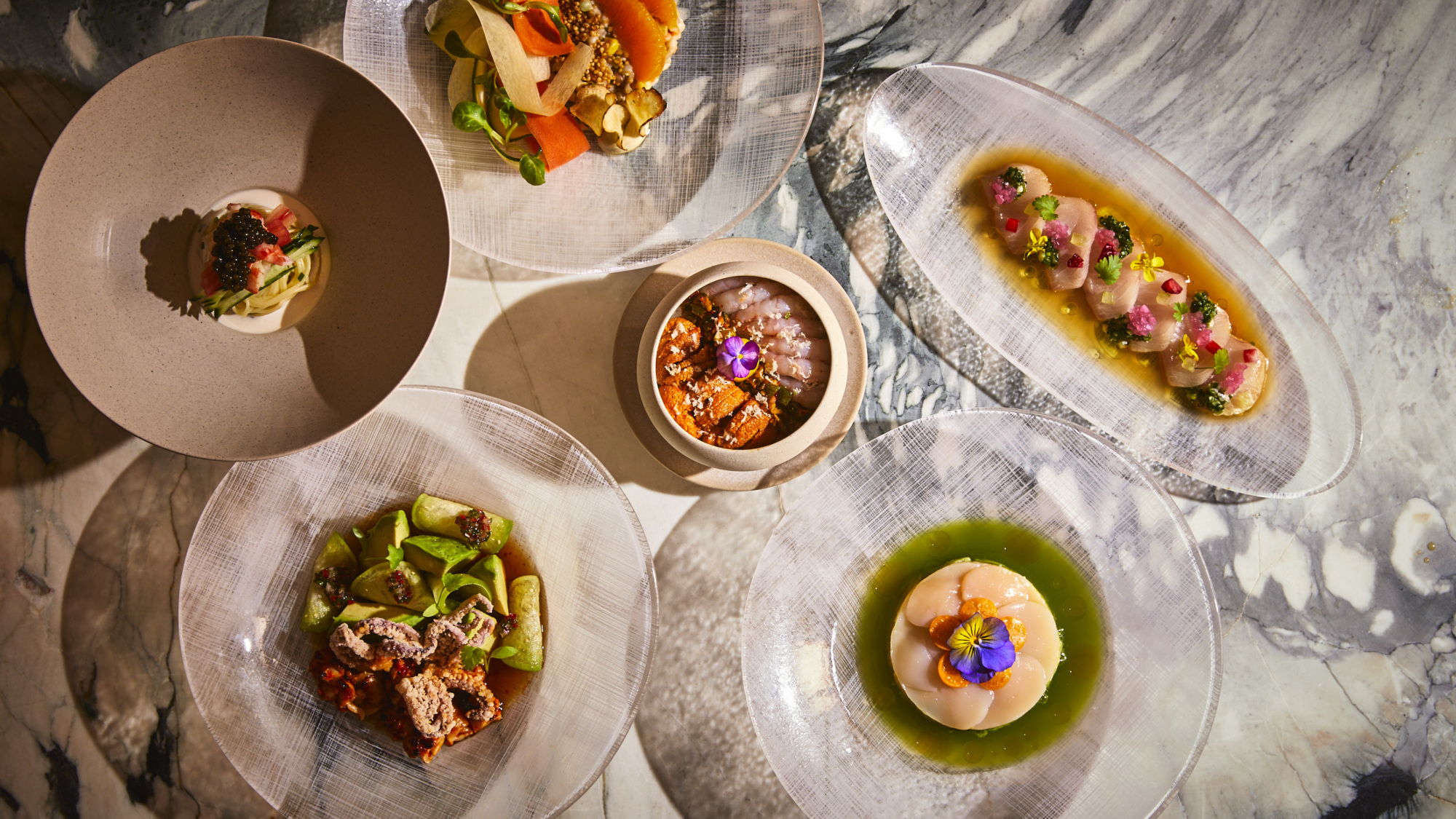
How Oiji Mi Crafts Globally Inspired Korean Fine Dining, in Five Dishes
First things first: Oiji Mi is not a fusion restaurant, in the sense that most fusion restaurants are portrayed. Executive chef and owner Brian Kim and managing partner Max Soh are very clear on that. Instead, the elegant sequel to popular East Village restaurant Oiji delivers traditional Korean flavors with contemporary riffs, very much influenced by New York restaurant culture.
Eight years ago, when Oiji first opened it made a splash serving small, shareable plates — 2015 was the peak of the tapas dining era in New York — like crisp roasted baby octopus tentacles and instantly iconic hot-out-of-the-fryer honey butter chips. It was food that was familiar to the New York restaurant enthusiasts and Korean diners alike, yet completely new.
Oiji Mi is an evolution of the original Oiji, echoing that same philosophy, but with a distinctly fine dining lens. Here, Kim pushes the boundaries of what Korean food can be. The flavors and ingredients are Korean and Korean American, with plenty of French bistro influence. Think pan-seared dover sole with gochugaru soy brown butter and a “Yukhwe” beef tartare served in a croustade. Oiji Mi offers a five-course prix-fixe menu ($125 per person) with three options for each course; you can also order a la carte at the bar and from the lounge.
“We’re not here to just be Korean,” Soh says. “We serve an Oiji style of food. It’s a brand, a style.”
Below, Kim shares some standout dishes from Oiji Mi’s opening menu.
- Turns Out Now Is the Golden Era for Fusion Cuisine
- The Ingredients May Be New. The Quest For Deliciousness Is Eternal.
- Sungchul Shim and the Beautiful Evolution of Korean American Cooking
- How To Treat Yourself at New York’s LittleMad, In Four Dishes
- The Five Dishes to Look for on Atoboy’s New Spring Menu
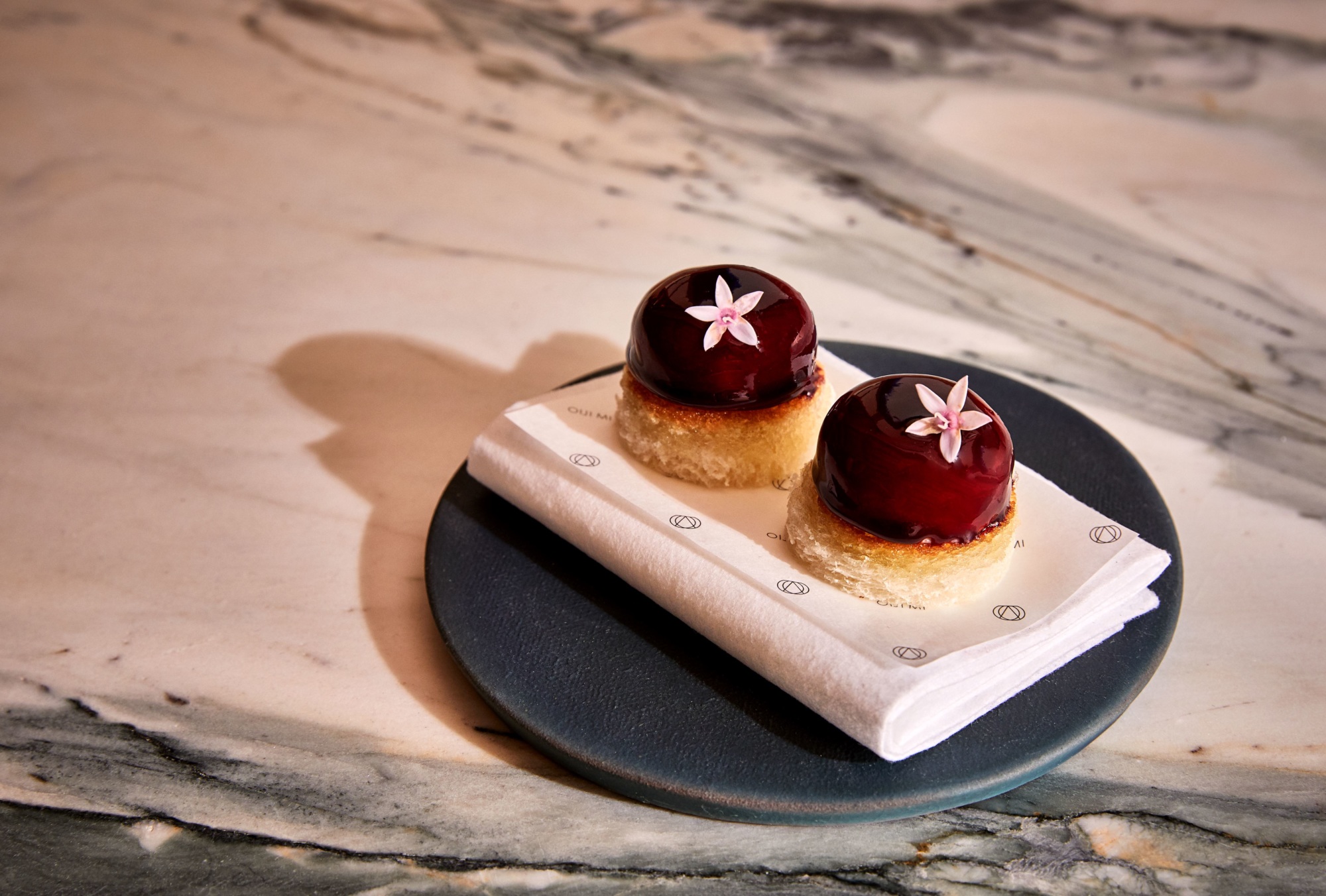
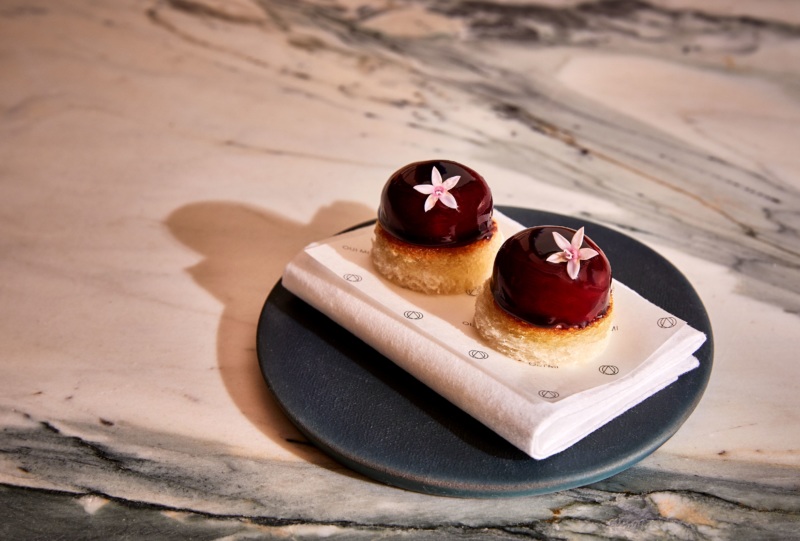
1. Foie Gras with Bokbunja Gastrique and Brioche
“We wanted to bring in high-quality ingredients that you would typically find in upscale restaurants in New York City, familiar New York City items, and you don’t want to miss out on foie gras. It’s definitely not a Korean ingredient — we don’t have [a tradition of eating] foie gras in Korea, but pork liver and cow liver are used to make steamed or stewed dishes.
“Korean wine, bokbunja, is a mountain berry liquor, so we made a gastrique out of it and incorporated pine nuts to give it a nuttiness. It’s a French technique, but we made it Korean. This item reflects the Oiji style — it’s more than just Korean or global styles, it is distinctly its own style of Oiji Mi cuisine.”
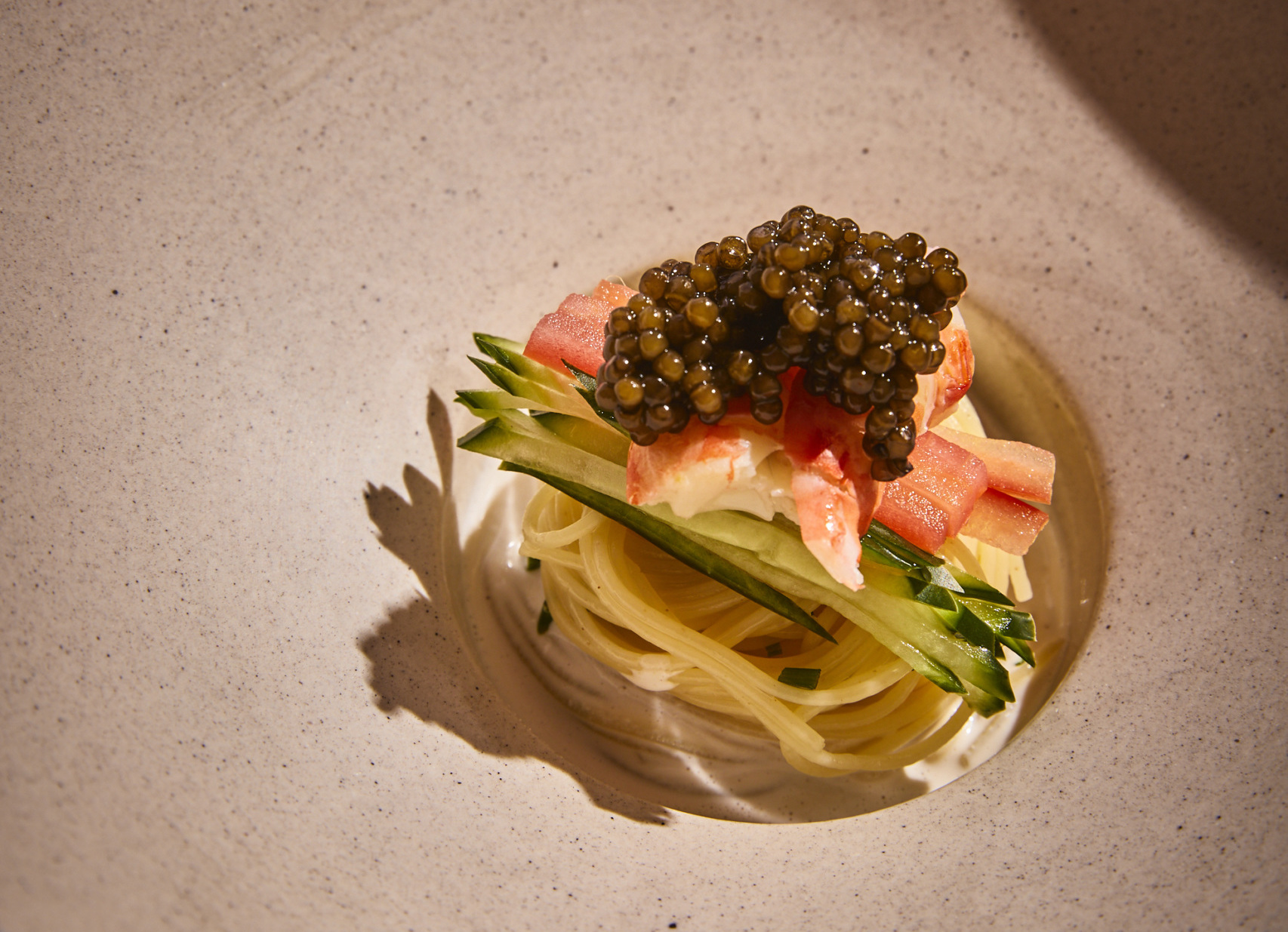
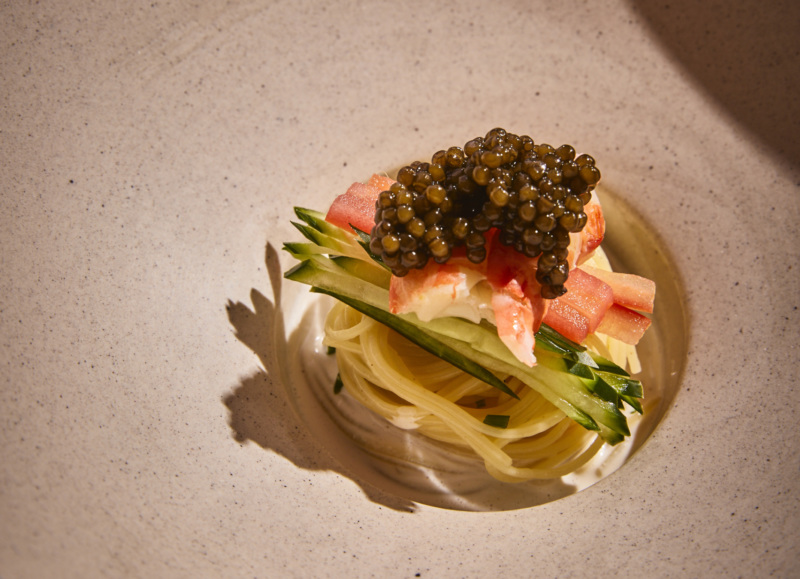
2. Cashew “Kong-Guksu”
Trout roe, capellini, pickled tomato
“Kong-Guksu is a cold noodle dish, a staple in Korea. Kong means beans or nuts, and guksu is a noodle. Traditionally, this dish is made using a soybean base. Often, people will mix it with peanuts or soy milk and may add cucumber and tomato, or sometimes a boiled egg. We use cashew nuts in our broth, in lieu of soybeans, as it gives a creamier, more flavorful texture. Cashews are not very popular in Korea, but when we were searching for nuts or beans that we could use, we found that cashews had so much flavor when they are made into broth. Our use of trout roe and caviar is not traditional, but we wanted to add accent and flavor to the dish.
“We use Italian capellini for texture. Classic Asian noodles like wheat or rice get very soft and will soak up the broth. Pasta tends to keep very firm. In U.S. culture, we like to have dishes with more texture, so for this dish, rather than a soggy noodle, we found that using capellini allowed it to remain al dente, accompanying the broth in a nice way. This merger lets us introduce people to dishes they may have never had before, but by giving them familiar items, like pasta, they are better able to understand the dish when they eat it. We pickle the tomatoes in house and the trout is from Denmark.”
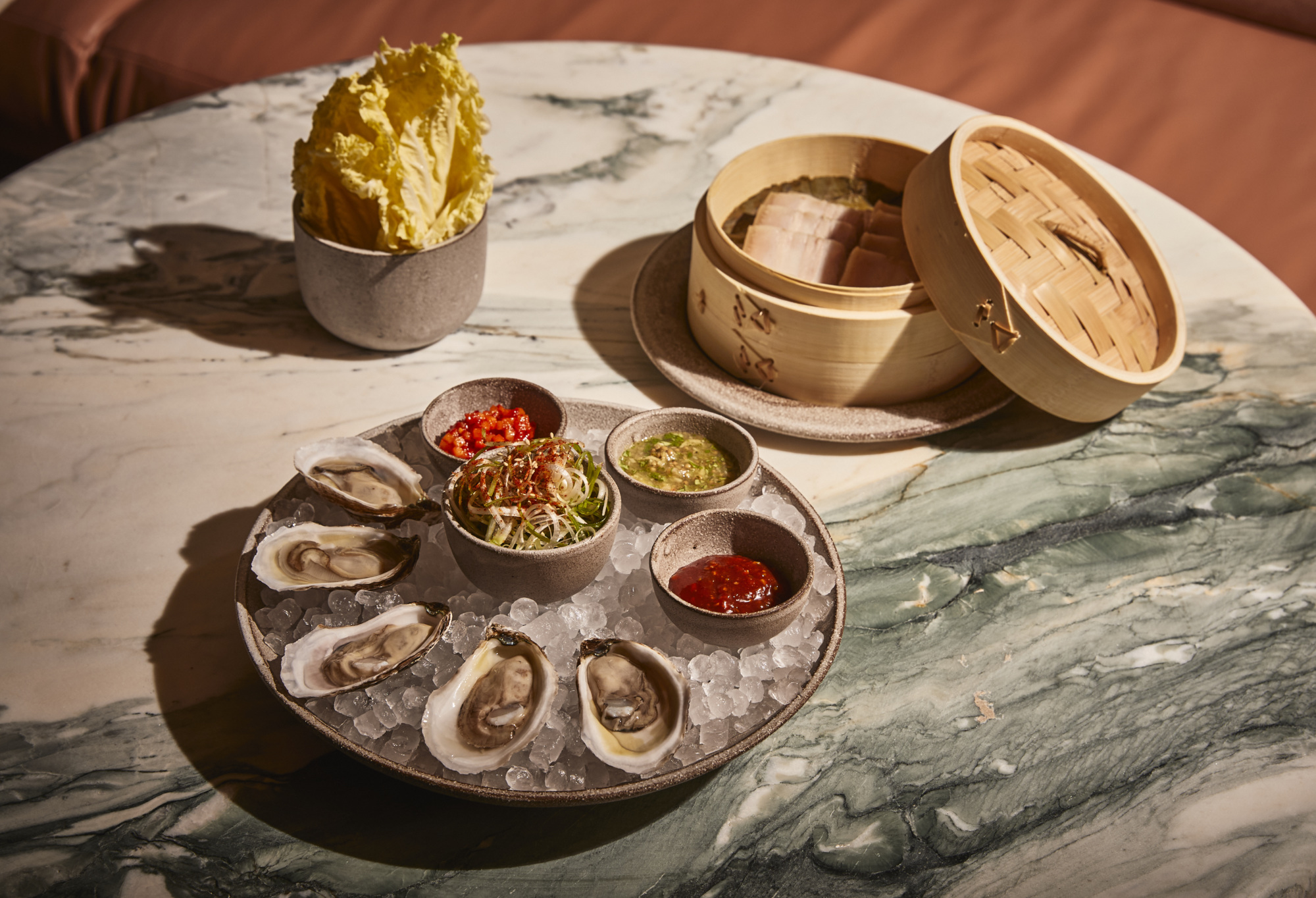
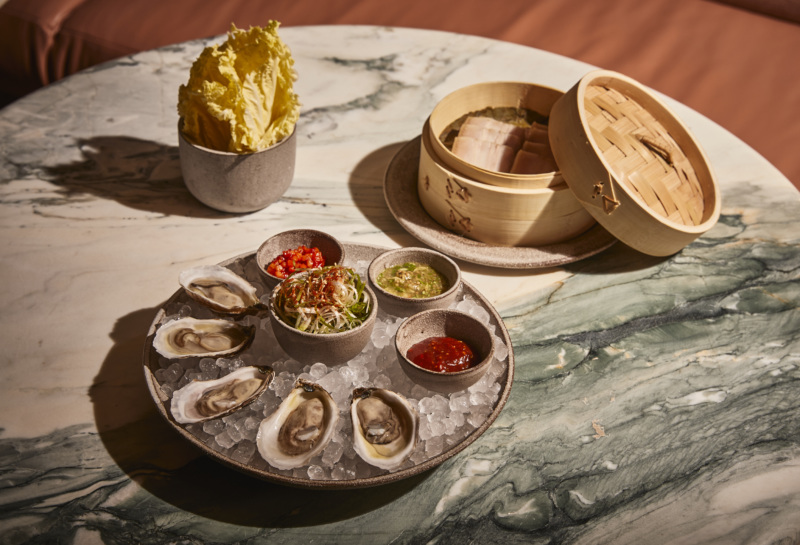
3. Bo Ssam
Heritage pork belly, oysters on the half shell, and spicy mustard mignonette
“This is one of our favorite dishes. In Korea, we always eat oysters, pork, and kimchi together. Knowing that in New York City people love oysters, we had to include them. But in Korea, they don’t really serve oysters in the half shell; they serve them without the shell, and they don’t plate oysters like a seafood tower [on ice]. We wanted to create a seafood tower-style dish with pork and shucked oysters with sauce on the side.
“Bo ssam is kind of a soul food in Korea. And then when you think about Korean cuisine, kimchi always comes first. We call the process of making kimchi kojong. Now, people are busy, so they aren’t making it much, but when I was growing up my mom and family would gather to make it together. Before it ferments, we eat the fresh kimchi sauce and salted cabbage, and cook pork belly and eat it with oysters. It’s very classic. Every Korean person has eaten this. It’s soul food, a core cultural Korean food. We combined a soul food of Korea with shucked oysters. It’s an East-meets-West dish. This presentation is familiar to New Yorkers. There’s a bamboo steamer with the pork belly in it, and Napa cabbage leaves, slightly salted, will be served with accoutrements.”
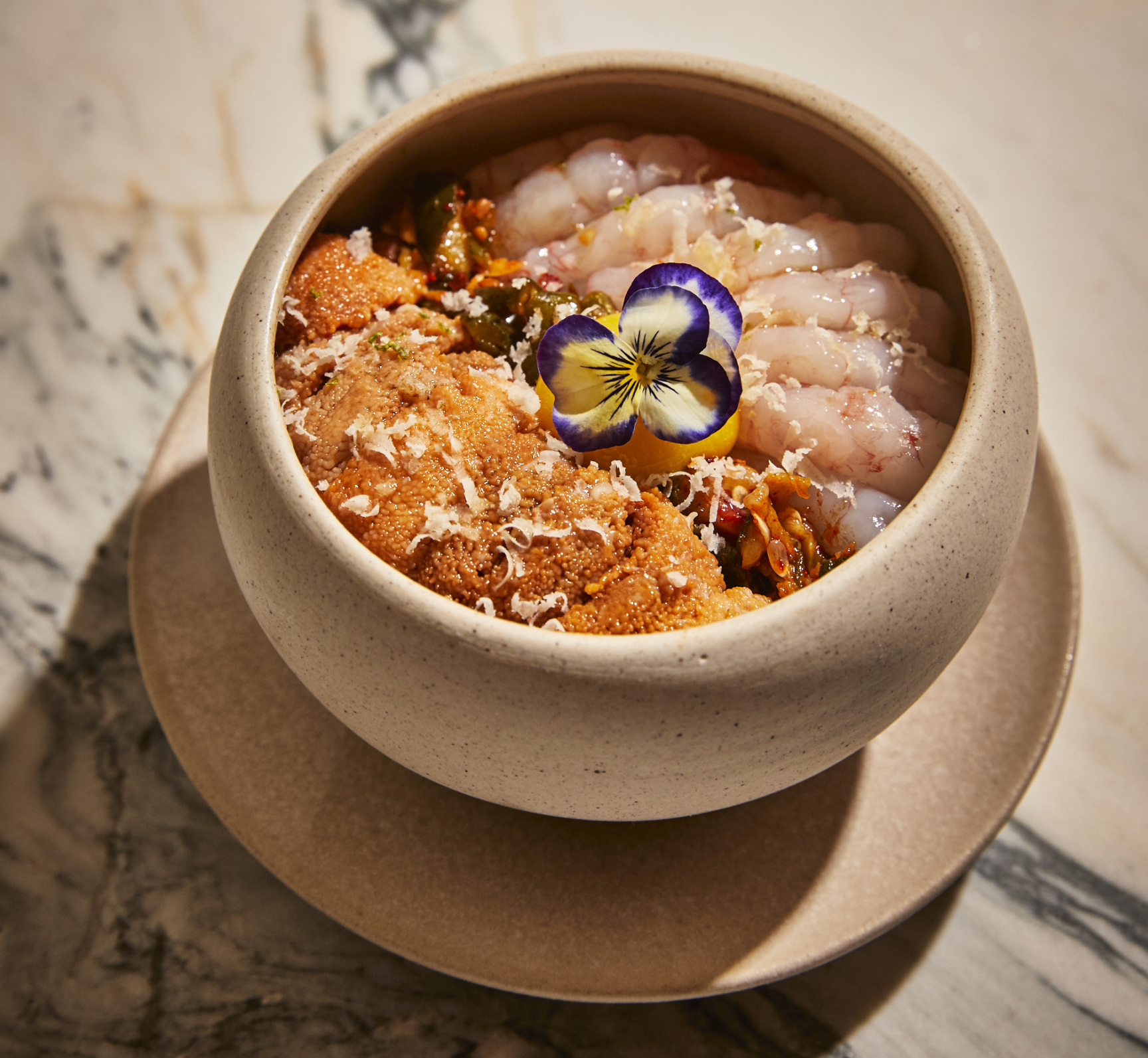
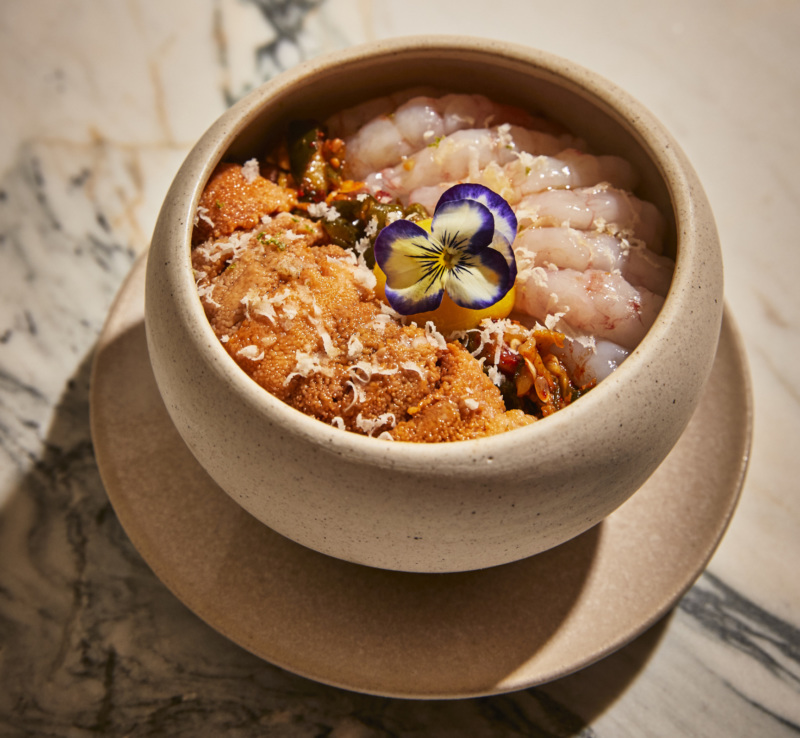
4. Oiji Bowl
Sea urchin, sweet shrimp, oiji, seaweed rice
“This is sea urchin rice dish is from Oiji and we’re bringing it over, along with 30% of the old menu. It’s very popular. We wanted to use sea urchin on our original menu; it’s been used in Japanese cuisine a lot and we wanted to recreate what you can eat from Jeju Island [which is known for its urchin divers]. This is one of the classic dishes Koreans have consumed for many, many years. American people know sea urchin as uni, which is a Japanese word.
We branded this as an Oiji bowl, and added our own cucumber as one of the components, because Oiji means ‘salty pickled cucumber’ in Korean. A lot of Korean restaurants still use the word uni, Italians may use rizzi or [riccio di mare]; we want to say sea urchin. For this dish in Korea, we use seaweed rice, made with vinegar, sesame oil and seasoning. On top, we have oiji and sea urchin. Unlike Japanese cuisine, which traditionally uses wasabi, we use horseradish for a kick and then top the dish with egg yolk. Traditionally, the egg is raw, but we use a gently cooked sous vide yolk, like an egg jelly, to change up the texture.”
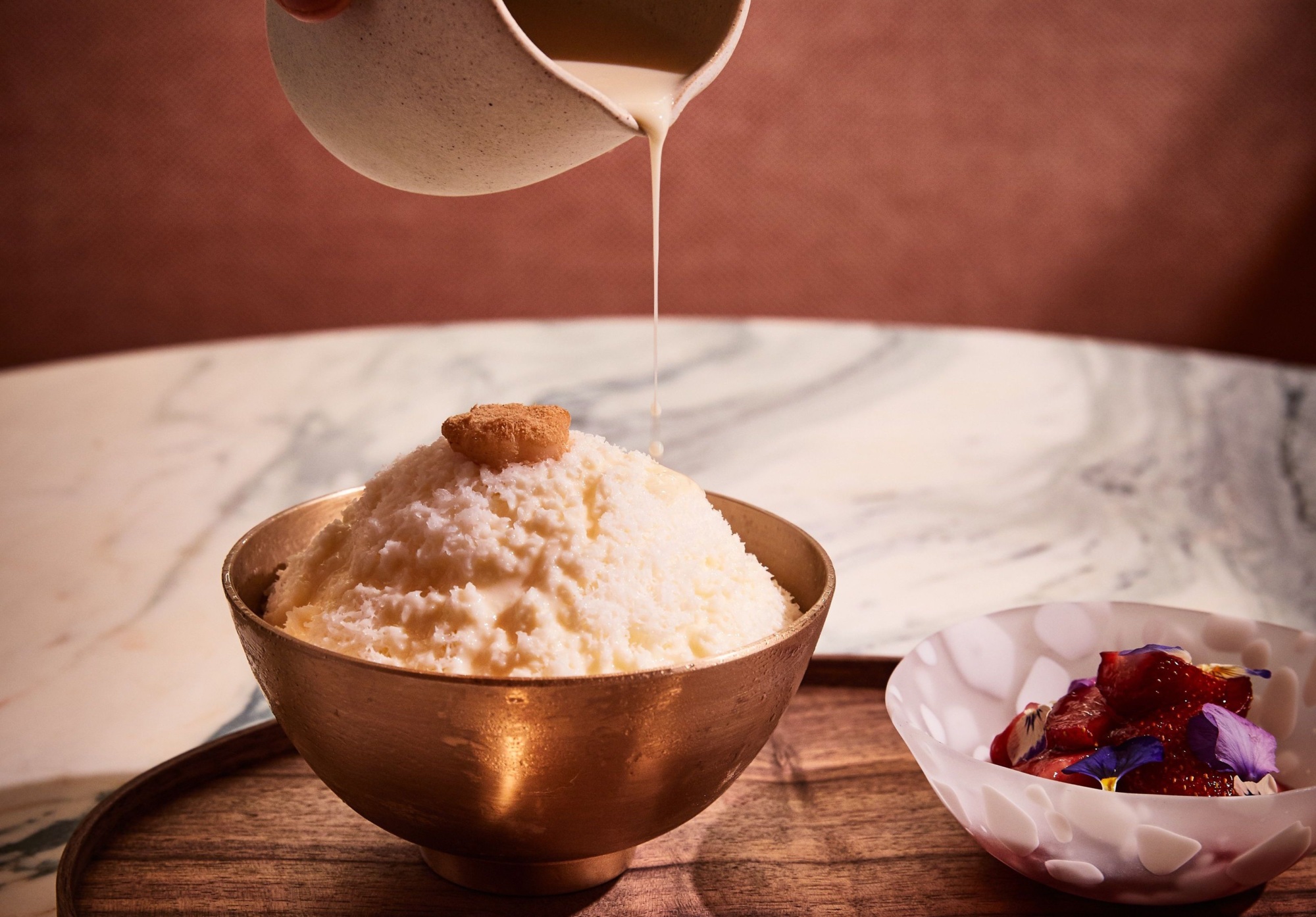
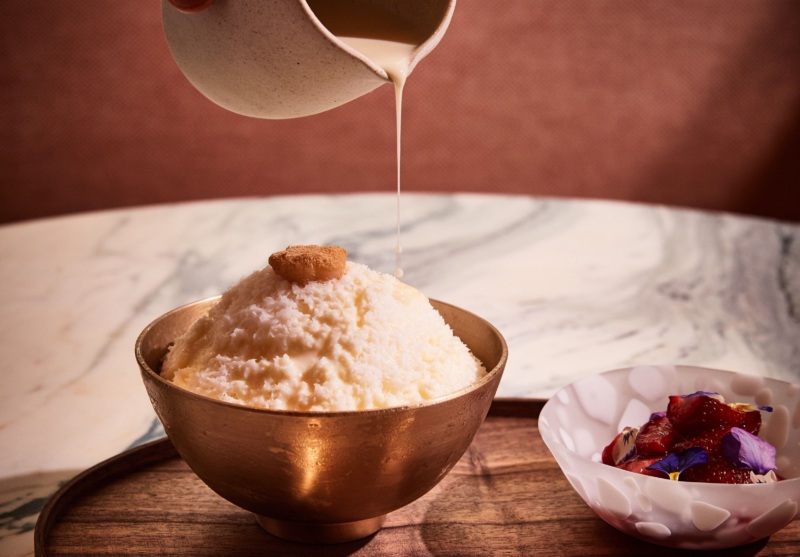
5. “Ooyoo” Bingsu
A2 origin milk, strawberry, injeolmi
“Bingsu is a staple dessert in Korea; it’s a Korean shaved ice. It’s one of the all-time favorite desserts. I really wanted to highlight its unique texture; it’s not like ice cream, sorbet, or even shaved Japanese or Taiwanese ice. The bingsu at Oiji Mi has the same texture as a snowflake.
“We plate the ingredients separately, because I want to stress texture first. After trying it on its own, we recommend adding the strawberry. Traditionally, at home, people will freeze water and milk and then shave it either with a knife or they might buy a machine that will grind it. There is a lot of variety when it comes to the flavors. Sometimes people will put fruit in the milk or the toppings are usually seasonal fruits like mango or watermelon. Sometimes people will do chocolate, caramel, or red bean. It’s very popular in the summer, but it’s also popular in the winter, since it’s a staple dessert.
“Our version is made using A2 milk. A2 is a variety of cows that are given no growth hormones and are grass-fed. These cows are from upstate New York and produce a very flavorful, creamy milk. We use A2 milk instead of cream, because cream makes the texture softer, like ice cream, and not flaky like bingsu. We tested out different milks and found that the A2 milk works best because it doesn’t melt as quickly and has great texture and flavor. We mix A2 milk with condensed milk and water and then run it through a machine that freezes and shaves it.
“We researched bingsu machines extensively and found the one that created the best texture. Each machine produces a different kind of texture and we were able to find one that produced the best qualities of bingsu texture found in Korea, the same texture as some of the most popular, top of the line spots in Korea.
“We use strawberries from Harry’s Berries in California. They are smaller than regular strawberries and have a lot of very concentrated flavor. They’re less watery than the version you find mass produced. Strawberry bingsu is a very classic flavor, but we may change it seasonally.
“Injeolmi are rice cakes and are not only traditional in this dish, but they are a staple in any Korean household. Our rice cakes are made in-house. We steam and then pound rice flour, water and sugar until it becomes really soft and chewy. It then gets rolled in roasted soybean powder. The technique is very traditional.”
Discover More

Stephen Satterfield's Corner Table




